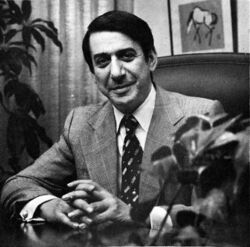Photorama
From Sega Retro

| |||||||||
| Photorama | |||||||||
|---|---|---|---|---|---|---|---|---|---|
| System(s): Arcade | |||||||||
| Publisher: Rosen Enterprises | |||||||||
| Developer: Rosen Enterprises | |||||||||
| Genre: Miscellaneous | |||||||||
| Number of players: 1 | |||||||||
|
This teeny-tiny article needs some work. You can help us by expanding it.
Photorama, also known by the name Two Minute Photo (二分写真)[1], is a photo booth developed by Rosen Enterprises and released exclusively to Japan in early 1954. An evolution of American photomat booths, it was specifically designed to produce long-lasting ID photographs, and quickly grew to become the single-most popular Japanese photograph service in the year following its release - even prompting the nation's photography industry to officially complain to the American Consulate. Following increased competition in the photo booth industry, Rosen Enterprises later shuddered their Photorama division in the early 1960s.
History
In the 1950s, Japanese citizens needed an photo ID for virtually everything: school applications, employment, ration cards, and more. Traditional photo studios of the era generally charged customers 250 yen, with photos taking 2 or 3 days to be developed, and few other alternatives available to the average consumer. To contrast, the United States hosted a market for popular automated photomat booth, where customers could enter a publicly-available booth and pay 25 cents to receive a series of four instant photographs.
Looking to enter this market, Rosen Enterprises began investigating into the subject further. Upon submitting the photos produced by photomat machines to longevity testing, David Rosen discovered that a lack of temperate control inside the booths would rendered the produced photos faded and unsuitable for ID photos after only a couple years. In particular, the existing machines lacked temperature control systems because most Americans were reportedly disinterested in getting a longer-lasting photo. In his designs for a new version of the hardware, Rosen decided to staff each booth with a live human, who would properly develop each set of photographs from a small enclosure behind the machine.
The company proceeded to acquire existing American photomat booths, redesigning them to their specifications and importing them into Japan in the beginning of 1954. Known under the new name of Photorama, these booths charged from 150 to 200 yen, and developed photographs in just a few minutes. These booths soon became a financial success - with over 100 new booths installed across Japan over the following year - and gaining the popular nickname nifun shashin (lit. "Two Minute Photo".) During particular times of the year which demanded a large number of ID photographs taken, such as school applications, it was not uncommon for customers to wait in Photorama lines for hours on end.
Photorama was so successful that traditional Japanese photo studios banded together and publicly voiced their protest to the American Consulate. The Consulate proceeded to call Rosen Enterprises directly to inform him of their concerns of unfair business practices. As a result, David Rosen worked out one of the earliest franchising deals in Japan, agreeing to make the Photorama system available for third-party franchisees. Rosen Enterprises would remain the hardware's proprietary supply supplier, and ended up opening another 100 booths after this deal was finalized.
Following increased competition in the photo booth industry, Rosen Enterprises officially wound down their Photorama division in the early 1960s.
References
- ↑ http://www.segakore.fr/index.php/2007/07/27/la-veritable-histoire-de-sega (Wayback Machine: 2024-04-23 23:58)
